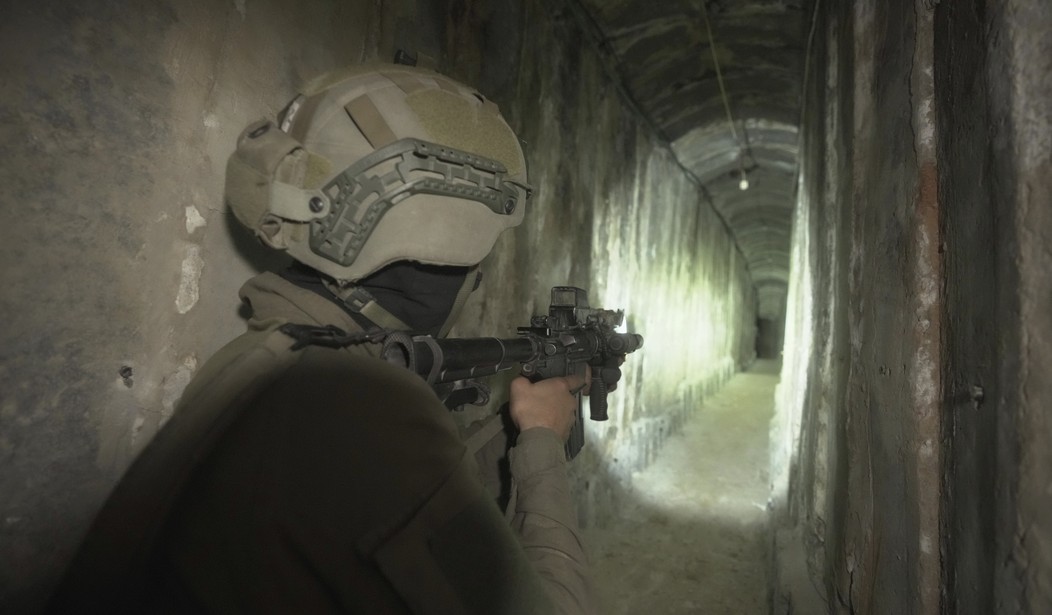Well, well, well. Hamas had insisted in recent days that it would release no hostages until the IDF withdrew from Gaza, a position that left the Israeli government in firm position to reject. After more losses on the battlefield, however, Hamas has had second thoughts.
Now they want a day of cease-fire for every hostage released, but without an IDF withdrawal. And the Israelis say …
Hamas negotiators have waived the condition of a final ceasefire and the withdrawal of IDF soldiers from Gaza in their ongoing talks with Israel for a second hostage release, according to a report by the Arab World News Agency (AWP), citing sources in Hamas.
“The five-way talks between Egypt, Qatar, the United States, Israel, and Hamas are ongoing, but so far no agreement has been reached,” the source told AWP, adding that talks have “accelerated significantly in recent hours,” with “Cairo and Doha making persistent efforts.”
The terrorist group is now open to the release of 40 hostages in exchange for 120 prisoners held by Israel, the report said, adding that Hamas had demanded a one-day ceasefire in exchange for each hostage released, but Israel refused.
That suggestion is absurd on its face, but the direction of concessions is certainly notable. Hamas still wants to wring strategic value from the hostages that remain in their hands, but Israel clearly wants to disincentivize future hostage taking by reducing that strategic leverage. They are still negotiating on a disproportional 1:3 basis, according to reports at the Jerusalem Post and other Israeli media, but even that’s limited to inmates arrested over less-serious charges. And even the 1:3 ratio is another retreat by Hamas, which had demanded thousands of prisoners exchanged for an estimated 133 hostages captured on October 7.
The change in direction comes as no surprise. First off, Hamas has a history of attempting to game negotiations by making outrageous demands, followed by a fallback to somewhat less-outrageous terms. But in this case, Hamas has suffered real and significant losses in the last few days that threaten to undermine their already-tottering regime in Gaza. The IDF killed one of their top commanders of the October 7 massacre, they announced yesterday, among other notable advances:
IDF troops continue operating in Gaza:
🔺ELIMINATED: Adil Mismah, the Nukhba Company Commander of Deir al-Balah who took part in Hamas’ October 7 invasion and massacre and attack on other communities surrounding Gaza.
🔺In Shejaiya, troops struck Hamas and Islamic Jihad terror…
— Israel Defense Forces (@IDF) January 1, 2024
And today, the IDF captured a key Hamas intel center in northern Gaza, on the outskirts of Gaza City, ending a battle that had “gone on for weeks,” according to the Jerusalem Post. The loss of this asset will likely blind Hamas in the north, and any intel captured in the seizure may well spell the end of Hamas leaders in the south — or force them to flee:
The IDF has completed its takeover of the second most important Hamas intelligence center in northern Gaza, as it finishes ousting the terror group from its last spot in Daraj-Tuffah. …
After the Hamas intelligence center found near the Gaza City military quarter, this intelligence center is considered the most important in northern Gaza, including 37 structures, a vast tunnel network dropping 20 meters underground, three tunnel elevators, extensive stairs, and blast doors.
Moreover, the complex included a diverse array of communications platforms which allowed directing the war with Hamas forces both in northern and southern Gaza as opposed to other command center positions focused merely on a specific more narrow area.
The very fact that Hamas fought to defend this position for weeks even while abandoning other parts of northern Gaza speaks to the value of this victory. The battle exposed an elaborate tunnel system connected to at least one mosque and one school, as well as the Rantisi Hospital. Hamas used these assets to coordinate sophisticated attacks for the last several weeks and lost hundreds of terror operatives in the process. According to the Post, the IDF also captured Hamas’ chief tunnel digger for this complex and got enough intel out of him to doom Hamas’ defense efforts, a point that will no doubt give the remaining operational centers even more worries when the Israelis start showing up outside their positions.
The tunnel network was destroyed by the IDF, but not before they shot this video:
The IDF says troops recently captured a Hamas stronghold in Gaza City’s Sheikh Radwan neighborhood, with special forces battling terror operatives inside tunnel networks beneath the site.
Hamas’s so-called Eastern Outpost is made up of 37 buildings “in the heart of the civilian… pic.twitter.com/yOZrPYI75V
— Emanuel (Mannie) Fabian (@manniefabian) January 2, 2024
In other areas of the stronghold, the IDF says troops of the Givati Brigade’s Shaked Battalion located five tunnel shafts, each dozens of meters deep, which all connect to each other via an underground network. The IDF says the tunnel network also connects to the main underground bunker.
Forces of the Air Force’s elite Shaldag unit entered one of the tunnels and battled Hamas gunmen underground, the IDF says, adding that “at the end of the fighting, all the terrorists were eliminated.”
The tunnel network was later destroyed by the Combat Engineering Corps’ 601st Battalion and elite Yahalom unit.
With these losses and intel captures in mind, it doesn’t seem surprising that Hamas has begun retreating from its absurd demands to something slightly less ludicrous. The Israelis won’t bite on either offer, not with this momentum building for a concentrated push in central and southern Gaza. The IDF announced the withdrawal of several brigades from the northern front, apparently satisfied that they can mop up with what Antony Blinken calls “lower intensity” operations in the north.
However, the Israelis are scaling up in the south. Defense minister Yoav Gallant made that clear in a visit today to central Gaza along the Salah-a-Din Road that the IDF secured in the early days of the war. The reduced units in the north will press down into central Gaza, while the IDF deploys more forces to Khan Younis to crush what’s left of Hamas’ central command — no matter how long it takes:
[Gallant] says the IDF is focused on what is above the Hamas tunnels in the Khan Younis area, “where senior Hamas officials are hiding, at great depths.”
“We are already reaching them… and it is happening already now,” Gallant says.
He says the fighting in southern Gaza will remain at “high intensity.”
“The results will be clear results,” Gallant vows. “We will end this campaign when Hamas does not function as a governing body and certainly not as a military framework… It will take time,” he says.
The intel captured in the battle for Sheikh Radwan could have a major impact on those operations — and Hamas knows it. What they need now is an extended pause in offensive operations to reorganize their forces and move their command operations to new locations in order to make that intel less valuable to the Israelis. Otherwise, they will have to try moving in the middle of “high intensity” operations, making their commanders even more vulnerable to the IDF.
Hence, the latest concessions as well as a play for 40 days of operational “pause.” The Israelis just fought and bled for that intel, and they are unlikely to simply give its value away at this stage of the conflict.









Join the conversation as a VIP Member